
Missile Command is a 1980 shoot 'em up arcade video game developed and published by Atari, Inc. and licensed to Sega for Japanese and European releases. It was designed by Dave Theurer, who also designed Atari's vector graphics game Tempest from the same year. The game was released during the Cold War, and the player uses a trackball to defend six cities from intercontinental ballistic missiles by launching anti-ballistic missiles from three bases.

Centipede is a 1981 fixed shooter arcade video game developed and published by Atari, Inc. Designed by Dona Bailey and Ed Logg, it was one of the most commercially successful games from the golden age of arcade video games and one of the first with a significant female player base. The primary objective is to shoot all the segments of a centipede that winds down the playing field. An arcade sequel, Millipede, followed in 1982.
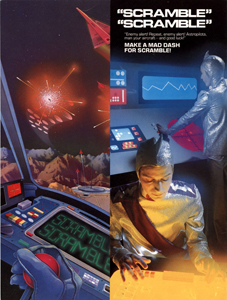
Scramble is a horizontally scrolling shooter arcade video game released in 1981. It was developed by Konami and manufactured and distributed by Leijac in Japan and Stern in North America. It was the first side-scrolling shooter with forced scrolling and multiple distinct levels, and it established the foundation for a new genre.

Defender is a horizontally scrolling shooter developed by Williams Electronics in 1980 and released as an arcade video game in 1981. The game is set on either an unnamed planet or city where the player must defeat waves of invading aliens while protecting astronauts. Development was led by Eugene Jarvis, a pinball programmer at Williams; Defender was Jarvis's first video game project and drew inspiration from Space Invaders and Asteroids. Defender was demonstrated in late 1980, before entering production in early 1981. It was distributed in Japan by Taito.
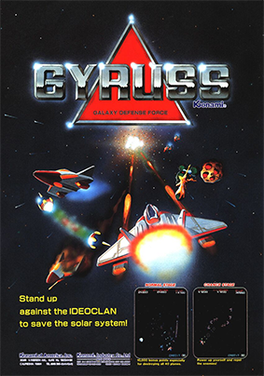
Gyruss is shoot 'em up arcade video game designed by Yoshiki Okamoto and released by Konami in 1983. Gyruss was initially licensed to Centuri in the United States for dedicated machines, before Konami released their own self-distributed conversion kits for the game. Parker Brothers released contemporary ports for home systems. An enhanced version for the Family Computer Disk System was released in 1988, which was released to the North American Nintendo Entertainment System in early 1989.

Track & Field, also known as Hyper Olympic in Japan and Europe, is an Olympic-themed sports video game developed by Konami and released as an arcade video game in 1983. The Japanese release sported an official license for the 1984 Summer Olympics. In Europe, the game was initially released under the Japanese title Hyper Olympic in 1983, before re-releasing under the US title Track & Field in early 1984.

Spy Hunter is a vehicular combat developed by Bally Midway and released for arcades in 1984. The game draws inspiration from the James Bond films and was originally supposed to carry the James Bond brand. The object of the game is to drive down roads in the technologically advanced "Interceptor" car and destroy various enemy vehicles with a variety of onboard weapons. Spy Hunter was produced in both sit-down and standard upright versions with the latter being more common. The game's controls consist of a steering wheel in the form of a futuristic aircraft-style yoke with several special-purpose buttons, a two-position stick shift, and a pedal used for acceleration.
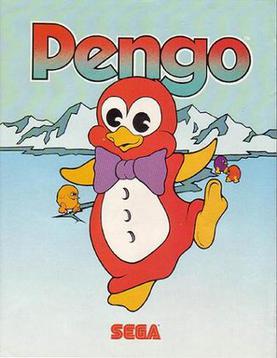
Pengo (ペンゴ) is an arcade video game developed by Coreland and published by Sega. It was first released in Japan on September 26, 1982, in North America the following month, and in Europe that December. The player controls Pengo, a red penguin that resides in the Antarctic. The game takes place in an overhead maze made of ice blocks, where Pengo crushes blob-like Sno-Bees by sliding blocks into them. The objective is to survive each round by eliminating all Sno-Bees and Sno-Bee eggs, while optionally lining up the three diamond blocks to earn a large score bonus.

Stargate is a horizontally scrolling shooter released as an arcade video game in 1981 by Williams Electronics. Created by Eugene Jarvis and Larry DeMar, it is a sequel to Defender which was released earlier in the year. It was the first of only three productions from Vid Kidz, an independent development house formed by Jarvis and DeMar. Some home ports of Stargate were renamed to Defender II for legal reasons.

Tempest is a 1981 arcade video game by Atari, Inc., designed and programmed by Dave Theurer. It takes place on a three-dimensional surface divided into lanes, sometimes as a closed tube, and viewed from one end. The player controls a claw-shaped "blaster" that sits on the edge of the surface, snapping from segment to segment as a rotary knob is turned, and can fire blaster shots to destroy enemies and obstacles by pressing a button.
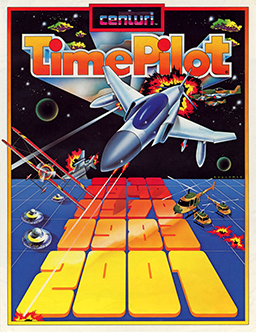
Time Pilot is a multidirectional shooter arcade video game designed by Yoshiki Okamoto and released by Konami in 1982. It was distributed in the United States by Centuri, and by Atari Ireland in Europe and the Middle East. While engaging in aerial combat, the player-controlled jet flies across open airspace that scrolls indefinitely in all directions. Each level is themed to a different time period. Home ports for the Atari 2600, MSX, and ColecoVision were released in 1983.

Phoenix is a fixed shooter video game developed for arcades in Japan and released in 1980 by Taito. The player controls a space ship shooting at incoming enemies that fly from the top of the screen down towards the player's ship. There are five stages which repeat endlessly. The fifth is a fight against a large enemy spaceship, making Phoenix one of the first shooters with a boss battle, an element that would become common for the genre.

Moon Patrol is a 1982 arcade video game developed and released by Irem. It was licensed to Williams for distribution in North America. The player controls a Moon buggy which can jump over and shoot obstacles on a horizontally scrolling landscape as well as shoot aerial attackers. Designed by Takashi Nishiyama, Moon Patrol is often credited with the introduction of full parallax scrolling in side-scrolling games. Cabinet art for the Williams version was done by Larry Day. Most of the home ports were from Atari, Inc., sometimes under the Atarisoft label.

Food Fight is an arcade video game developed by General Computer Corporation and released by Atari, Inc. in March 1983. The player guides Charley Chuck, who is trying to eat an ice cream cone before it melts, while avoiding four chefs bent on stopping him. 1,951 arcade cabinets were sold.

Gravitar is a color vector graphics multidirectional shooter arcade video game released by Atari, Inc. in 1982. Using the same "rotate-and-thrust" controls as Asteroids and Space Duel, the game was known for its high level of difficulty. It was the first of over twenty games Mike Hally designed and produced for Atari. The main programmer was Rich Adam and the cabinet art was designed by Brad Chaboya. Over 5,427 cabinets were produced. An Atari 2600 version by Dan Hitchens was published by Atari in 1983.

Chopper Command is a horizontally scrolling shooter released by Activision for the Atari 2600 in June 1982. It was written by Bob Whitehead. The player flies a helicopter left and right over a scrolling, wraparound landscape, shooting down enemy airplanes to protect a convoy of trucks below.

Super Cobra is a horizontally scrolling shooter developed by Konami, originally released as an arcade video game in 1981. It was published by Konami in Japan in March 1981 and manufactured and distributed by Stern in North America on June 22. It is the spiritual sequel to the Scramble arcade game released earlier in 1981. Super Cobra contains eleven distinct sections, versus six in Scramble, and is significantly more difficult, requiring maneuvering through tight spaces early in the game.
Blaster is a first-person rail shooter released as an arcade video game by Williams Electronics in 1983. It was developed by Eugene Jarvis and Larry DeMar. A vague sequel to Robotron: 2084, the game is a shoot 'em up set in outer space. The goal is to destroy enemies, avoid obstacles, and rescue astronauts in twenty levels, to reach paradise.

Tutankham is a 1982 arcade video game developed and released by Konami and released by Stern in North America. Named after the Egyptian pharaoh Tutankhamun, the game combines a maze shoot 'em up with light puzzle-solving elements. It debuted at the European ATE and IMA amusement shows in January 1982, before releasing worldwide in Summer 1982. The game was a critical and commercial success and was ported to home systems by Parker Brothers.
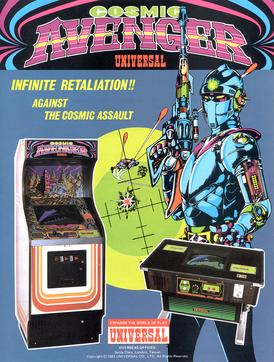
Cosmic Avenger is a scrolling shooter developed by Universal and released as an arcade video game in July 1981. It is part of the first wave shooters with forced horizontal scrolling which followed Konami's Scramble and Super Cobra from earlier in the year. It was released the same month as Vanguard. The final installment in Universal's Cosmic series, players take control of the Avenger space fighter and, as in Scramble, use bullets and bombs against enemy air and ground forces. The world is one continuous level made up of different areas.





















